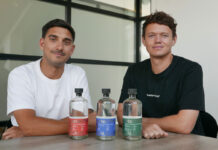Producers will continue to innovate as the category goes from strength to strength

Few in the trade could have foreseen the current gin boom, and it would have taken a potent crystal ball to predict the sheer range of flavours and styles that now occupy Scotland’s back-bars.
From fruit gins to liqueurs, exotic botanicals to barrel-aged spirit, there has been no shortage of innovation in the category.
“Gin has experienced huge demand over the last few years, with new brands entering the category and bringing about new innovation, particularly amongst craft brands,” said Jen Draper, marketing director for mixer brand Franklin & Sons at parent company Global Brands.
“The UK comprises 72% of the total EU production of gin, showing just how popular it has become amongst consumers.”
And drinks companies have predicted there will be no shortage of new, non-traditional, gins in the months and years ahead.
“If you look at the top gin sellers on Amazon right now, only two gins are anything approaching a traditional London Dry,” said James Porteous, director and distiller at Electric Spirits Co.
Gin is doing what every area of the market has done as it’s grown: moved to sweeter, fruity products.
“Every other gin on there has a heavy fruit or floral flavouring.
“The gin market is doing what every area of the drinks industry has done as it has grown: moved to sweeter, fruity products which appeal to a larger number of drinkers. It’s happened in cider, sparkling wine, even craft beer.
“I’d expect more producers to chase after this segment, so I fully expect more fruit liqueurs, and more heavily flavoured gin products, but I’d also expect to see a shift as consumers realise there’s a whole category of un-fruited, un-sweetened gins to move on to.”
Carlo Valente, director of VC2 Brands, the company behind Boë Gin, agreed.
“Flavoured gins have had extraordinary success – with a 740% increase in sales for 2018 from the previous year this trend is set to continue,” he said.
“Flavoured gins are bringing new and younger gin drinkers into the category, many of which are preferring lemonade rather than the traditional Indian tonic water to go with their new colourful flavoured gins.”
However, with so many brands now on the market it is inevitably becoming more difficult for new products to differentiate themselves, both to the bar and pub operators stocking them and to consumers.
Amanda McLeod, marketing director at Hi-Spirits, the distributor of gin brands including Brooklyn Gin and Scapegrace, said this will likely be the biggest challenge for any new brands and products entering the market in 2019.
“We haven’t reached ‘peak gin’ yet in terms of the number of brands or consumer interest in the category,” said McLeod.
“The challenge for brands will continue to be how to differentiate in a crowded market.
“The general trend is for consumers to drink less but drink better, so premium and authentic gin serves are likely to have the most traction across both classic and flavoured gins.”
We haven’t reached ‘peak gin’ yet in terms of the number of brands or consumer interest.
Provenance will also continue to be an important factor in differentiating gins and Moira Swan, drinks buyer at wholesaler Inverarity Morton, said with craft gin, in particular, “it’s all about provenance”.
“That means championing local ingredients, so using indigenous grains or botanicals,” said Swan.
“Scotland produces over 70% of gins in the UK so think local when it comes to choosing craft.”
Ultimately, the pressure is on drinks companies to offer the on-trade something they can’t get from another producer.
Style over substance simply won’t cut it.
“It’s all about the overall appeal – the full package,” said Dale McQueen, co-founder of McQueen Gin.
“It quite simply isn’t enough to have a pretty bottle, or a strange flavour that can’t be gotten elsewhere.
“Producers must be able to offer the highest quality products, beautifully distilled and presented, whilst also having that differentiating factor that will make licensees and bartenders find it impossible to not stock their products.”



















